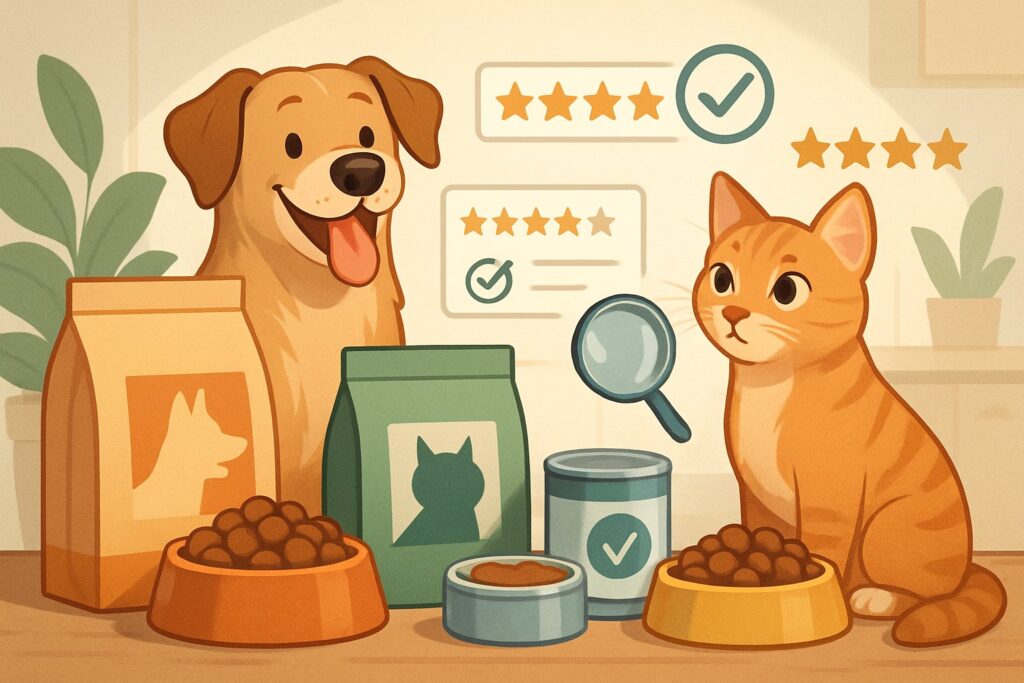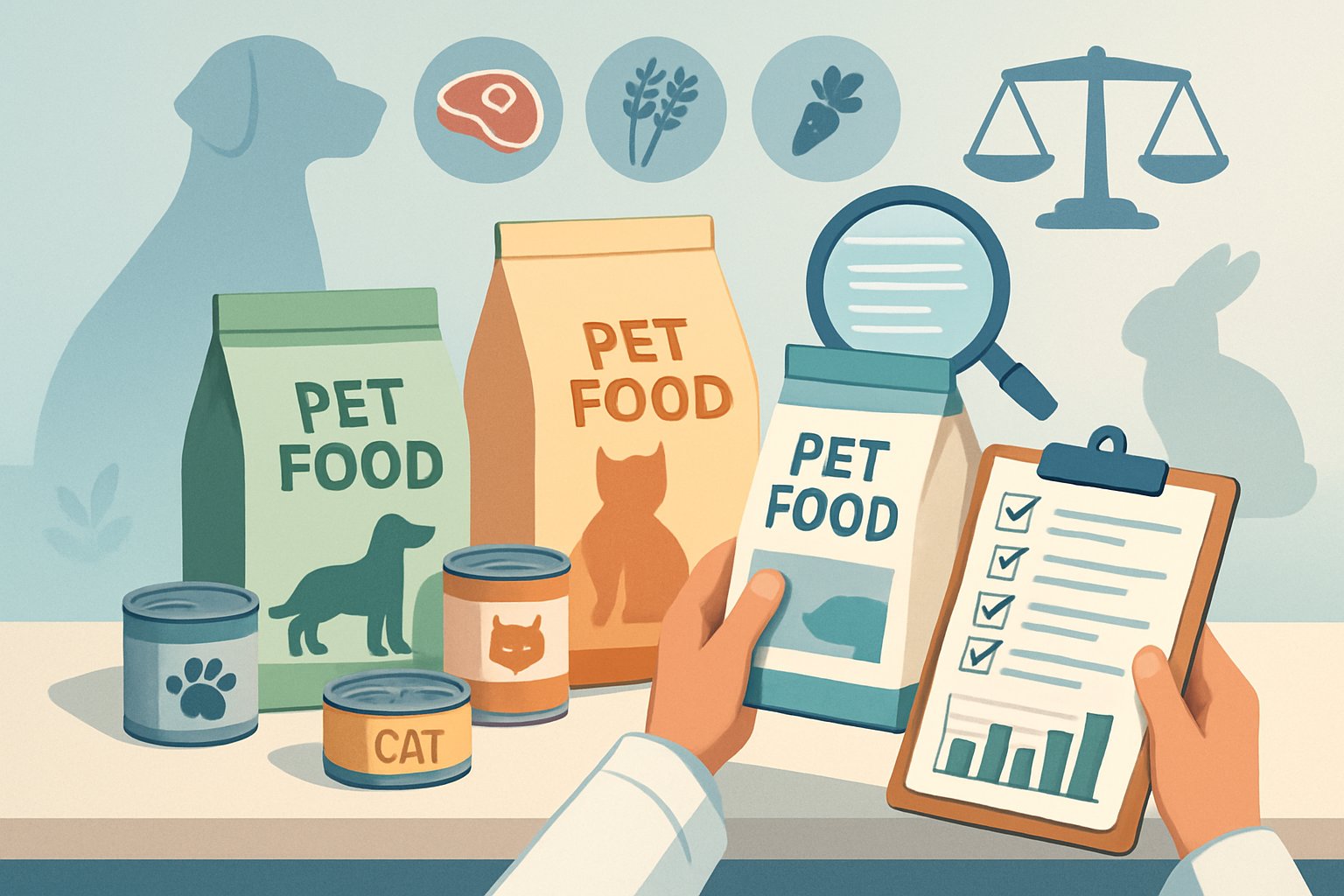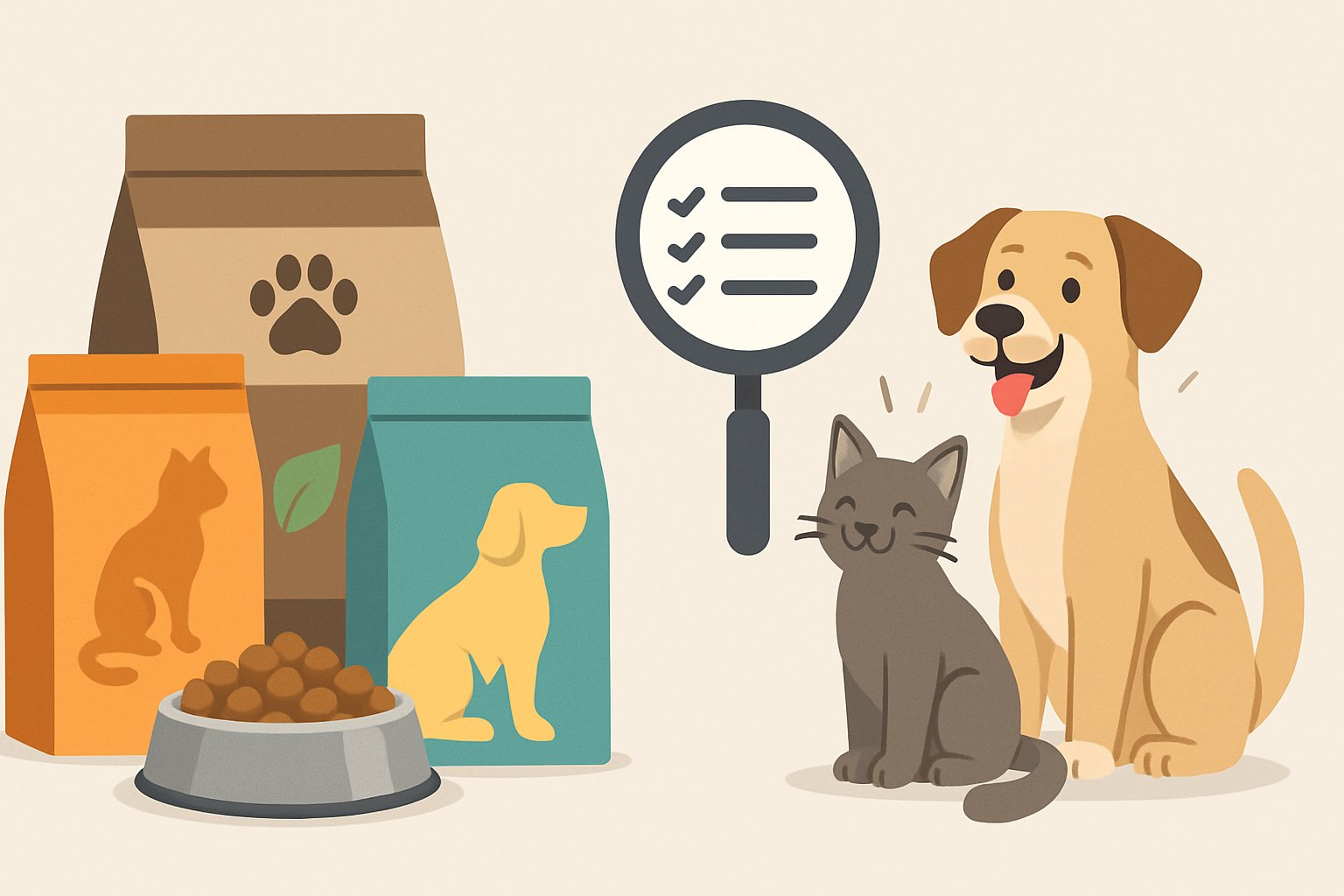When I started looking into pet food brands for my own dog, it hit me fast—flashy marketing doesn’t always line up with what’s actually in the bowl.
The best pet food brands come down to ingredient quality, manufacturing standards, customer reviews, and how well they meet your specific pet’s nutritional needs—not just clever promises on a bag.
Most pet parents grab food based on price or packaging. But honestly, the real story is in what sets truly good brands apart from those just talking a big game.

Table of Contents
I’ve spent way too many hours digging through online customer reviews and product analysis to figure out which brands actually deliver. What surprised me? Some of the most expensive brands weren’t the best, while a few lesser-known companies got rave reviews from pet owners who saw real changes in their dogs’ health and energy.
So here’s my honest breakdown of popular pet food brands—the red flags I wish I’d spotted earlier, and the standouts that genuinely impressed me.
I’ll walk you through how to decode ingredient lists, spot marketing tricks, and find the food that fits your dog’s needs and your budget.
Pet Food Brand Reviews – Key Takeaways
- Quality pet food brands focus on transparent ingredient sourcing and manufacturing standards, not just flashy marketing
- Reading online reviews from real customers tells you more than brand ads or even some vet recommendations
- The best food for your dog depends on their age, breed, health, and activity—not a one-size-fits-all label
What Makes or Breaks a Pet Food Brand

Brand reputation in the pet food world really boils down to three things: ingredient quality, meeting nutritional standards, and how transparent a company stays during recalls.
Ingredient Quality and Sourcing
I’ve watched lots of pet owners buy food without a clue where the ingredients come from. But your dog’s health starts with what’s in that bag.
Premium brands source ingredients domestically and use whole meats and named proteins. They skip vague stuff like “meat meal” or “poultry by-products.”
Watch for these red flags on ingredient lists:
- Generic terms like “animal fat”
- Chemical preservatives (BHA, BHT, ethoxyquin)
- Too much corn gluten meal
- Artificial colors and flavors
The best brands tell you exactly where their chicken, beef, or fish comes from. Some even name the farms.
Research shows that pet food price fairness and brand reputation really drive what people buy. Ingredient transparency always tops my checklist.
Fresh beats processed. Brands using freeze-dried or dehydrated ingredients usually offer higher nutritional value than heavily processed kibble.
Nutritional Standards and Testing
Every reputable pet food brand should meet AAFCO standards. But honestly, that’s just the bare minimum.
I look for brands that go further. They run feeding trials—not just lab analysis. Feeding trials show real results with actual dogs over time.
Here’s what separates the good from the great:
Testing protocols matter. Top brands test every batch for:
- Nutritional content
- Contamination (salmonella, listeria)
- Heavy metals
- Mycotoxins
Plenty of budget brands skip these pricey tests. That’s where health concerns start stacking up.
Life stage formulas show real expertise. Puppies need different nutrition than seniors. Brands making specific recipes for different ages really get canine nutrition.
Be careful with brands making medical claims without vet backing. No dog food “cures” diabetes or kidney disease, no matter what the marketing says.
Transparency and Recall History
I always check a brand’s recall history before I recommend anything. It tells you a lot about their quality control.
Good brands own their recalls. They notify customers fast, explain what happened, and show what they did to fix it.
Red flags for me:
- Multiple recalls in recent years
- Same issue, over and over
- Poor communication during recalls
- Blaming suppliers instead of taking responsibility
Some brands have never had a recall. That’s either amazing quality control or, honestly, maybe they’re not testing enough. I prefer brands with minimal, well-handled recalls over those claiming perfection.
Online customer reviews reveal problems company websites won’t. I read through complaints about digestive issues, packaging, or sudden formula changes.
Manufacturing transparency matters too. Brands should tell you which facilities make their food and what certifications those plants have.
The most trusted brands publish annual reports showing their testing results, sourcing changes, and quality improvements. They’re not hiding from pet parents.
Honest Reviews of Popular Dog Food Brands
I’ve tested dozens of dog food brands, and the differences can be wild. From fresh meal delivery that shows up at your door to budget kibbles that still pack nutrition, each category serves different needs and wallets.
Standout Fresh Dog Food: The Farmer’s Dog, Nom Nom, Freshpet
The day I switched my golden retriever to fresh food? Total game changer.
The Farmer’s Dog tops my fresh food picks with custom meal plans tailored to your dog’s exact needs. I love how they factor in age, weight, and activity. Meals arrive frozen in perfect portions.
Their ingredients are human-grade. Real turkey, sweet potatoes, carrots—stuff you’d eat yourself. My dog’s coat got shinier within weeks.
Nom Nom impressed me with their vet-formulated recipes and detailed nutrition info. Their customer service actually answers questions fast. The packaging keeps meals fresh during shipping.
Freshpet wins for convenience since you can grab it at most grocery stores. I keep their rolls in my fridge for easy serving. The Select line uses high-quality proteins and skips fillers.
Price reality check: Fresh food costs three or four times more than kibble. But I’ve seen fewer vet visits and better energy levels in dogs eating fresh diets.
Kibble Kings: Blue Buffalo, IAMS, Canidae, Nature’s Logic
Kibble still feeds most dogs in America, and these brands prove dry food can be solid nutrition when done right.
Blue Buffalo earned my respect with their Life Protection Formula. Real chicken is the first ingredient, not chicken meal. I appreciate their LifeSource Bits—those dark kibbles full of antioxidants.
The brand ran into controversy years ago over ingredient sourcing. They’ve stepped up transparency and quality since then.
IAMS surprised me as a budget pick that doesn’t cut corners on nutrition. Their ProActive Health line includes prebiotics for digestion. My friend’s lab thrived on it for years.
Canidae is on my list for their All Life Stages formula. One bag works for puppies and seniors. The ingredient list stays clean with real whole foods.
Nature’s Logic takes the all-natural thing seriously. No synthetic vitamins or minerals—they use whole foods like dried kelp and montmorillonite clay. It’s pricier but a solid choice for sensitive dogs.
Premium and Specialty Picks: Orijen, Open Farm, Instinct, Nulo
These brands are for pet parents who want the absolute best, no matter the price.
Orijen makes what I call “ancestral diets”—high protein formulas based on what wolves eat. Their Regional Red formula has wild boar, bison, and lamb. It’s rich, so go slow when switching.
I’ve seen amazing results in working dogs and active breeds on Orijen. Protein content hits 38-40% in most formulas.
Open Farm scores for transparency. You can trace every ingredient to the source farm. Their humanely raised proteins and non-GMO produce appeal to conscious shoppers.
Instinct by Nature’s Variety does freeze-dried raw coated kibble that dogs go nuts for. The raw coating adds probiotics and flavor. Their Limited Ingredient Diets work well for allergic pups.
Nulo offers grain-free recipes with high meat and low glycemic ingredients. I like their puppy formulas with DHA for brain development. The small kibble size is great for tiny breeds.
Research shows that pet food marketing strategies focus hard on premium positioning and ingredient transparency for these high-end brands.
Budget and Everyday Choices: Merrick, Taste of the Wild, A Pup Above
You don’t have to spend a fortune for good nutrition. These brands prove it.
Merrick delivers premium ingredients at mid-range prices. Their Classic recipes start with deboned meat. I’ve fed their Backcountry line to hunting dogs with great results.
The brand got bought by Purina, which made some fans nervous. Quality has stayed solid in my experience.
Taste of the Wild brings exotic proteins like venison and salmon at grocery store prices. Their grain-free formulas include probiotics and antioxidants. Dogs love the flavors.
A Pup Above bridges fresh and kibble with sous-vide cooked meals. You can buy them frozen or shelf-stable. The texture feels more like real meat than processed kibble.
Merrick recently added more wet food with whole ingredients you can actually see. The chunks of sweet potato and peas look good enough for people.
Consumer reviews analysis shows pet owners want real meat and transparent labels, and these brands deliver at prices that aren’t out of reach.
How to Decipher Brand Promises Versus Real Results

Pet food companies love to brag about nutrition and health benefits. But honestly, separating marketing hype from real results means looking past all that flashy packaging.
I’ve figured out that the secret is digging into actual customer feedback, catching sneaky marketing moves, and knowing which health claims really matter.
Evaluating Customer Reviews and Social Buzz
Ever notice those perfect before-and-after photos in pet food ads? I always go deeper to see what real customers are actually saying.
When I scan dog food reviews and customer experiences, I hunt for details. The best reviews talk about specific changes, like “my dog’s energy improved after three weeks,” instead of just “best food ever.”
Timing matters too. If a bunch of five-star reviews pop up all at once, something’s off. Real owners usually share their stories after weeks or months with a food.
Social media is where the truth comes out. I scroll through Instagram hashtags and Facebook groups, because that’s where pet parents vent about issues brands never mention.
Research shows user reviews and ratings seriously influence pet food choices. I focus on reviews that mention the same health stuff my dog deals with.
Red flags in reviews:
- Way too many perfect ratings
- Copy-paste language in different reviews
- No mention of switching foods or adjustment time
- All about packaging, not results
Spotting Marketing Red Flags
Let me tell you, pet food brands have some sneaky tricks to make their products sound better than they are.
Meaningless buzzwords are everywhere. Stuff like “premium,” “gourmet,” or “restaurant-quality” sounds fancy but means nothing legally. I just ignore it and check the ingredient list.
Wild promises make me pause. If a brand claims “transforms your dog’s health in days” or “eliminates all allergies,” that’s a red flag. Real changes take time—weeks, not days.
Misleading ingredient marketing is common. When brands hype one ingredient but list it at the end, it’s mostly for show. I always check where ingredients rank by weight.
Photos can lie, too. Those perfect kibble shots and grinning dogs rarely show what you’ll actually get. I trust brands that set realistic expectations, not miracle claims.
Price tricks get me suspicious. Sometimes brands charge a ton just to seem “premium.” Expensive doesn’t always mean healthier for your pup.
Recognizing Legitimate Health Benefits
I’ve learned to spot which health claims actually matter for my dog’s wellbeing and which are just marketing noise.
Real benefits take time. Improvements in coat shine, energy, or digestion usually show up after 4-6 weeks of the same food. If a brand promises instant results, I don’t buy it.
I look for specific, research-backed claims. “Contains omega-3 fatty acids for skin health” is way more believable than “gives your dog a lustrous coat.”
If my dog has allergies, I read reviews from pet parents dealing with the same thing. Generic health claims don’t help when you need something specific.
Legit brands share detailed nutritional info—not just the basics. I can actually contact their customer service and get answers about protein sources, processing, and quality tests.
Evidence-based ingredients matter. Probiotics for digestion, glucosamine for joint support, and certain proteins for allergies have real research behind them.
I trust brands that admit their food isn’t perfect for every dog. If a company claims their food works for every pup, I’m skeptical.
Choosing the Best Food for Your Pup’s Needs
I’ve seen so many dog parents frozen in pet store aisles, totally overwhelmed by all the choices. It comes down to matching your dog’s health needs with the right ingredients, knowing their life stage, and deciding on dry kibble or fresh food.
Matching Ingredients to Your Dog’s Health
Ever catch your pup scratching nonstop or having tummy trouble? I’ve learned that picking the right food for dogs can be tough, but it starts with reading ingredient lists like a detective.
For sensitive stomachs, I look for:
- Single protein sources (like just chicken or just lamb)
- Limited ingredients (under 10 total)
- No artificial colors or preservatives
If your dog has skin allergies, steer clear of:
- Beef and chicken (top allergens)
- Wheat, corn, and soy
- Preservatives like BHA and BHT
I always check the first five ingredients. That’s where the real nutrition is. If I see “chicken meal” instead of “chicken,” that’s actually a win—more protein packed in.
Pro tip: Switch foods slowly over 7-10 days. Start with 25% new food and 75% old, then gradually increase the new stuff.
Understanding Life Stage Formulas
I wish someone told me sooner—puppy food isn’t just a marketing ploy. Dogs’ nutritional needs change as they age.
Puppy Stage (0-12 months):
- At least 22% protein
- More fat for brain growth
- Small kibble for little mouths
- Feed 3-4 times a day
Adult Dogs (1-7 years):
- 18% protein minimum
- Balanced fat (8-15%)
- Keep weight steady
- Two meals daily
Senior Dogs (7+ years):
- Easy-to-digest proteins
- Glucosamine for joints
- Lower calories to avoid weight gain
- Softer food if needed
I kept my lab on puppy food too long once, and he packed on 15 pounds in three months. Trust me, life stage formulas exist for a reason.
Dry Dog Food vs. Fresh or Wet Diets
Honestly, I used to think dry dog food was just the cheap, boring option. Turns out, quality beats format every time.
Dry Dog Food Perks:
- Super convenient
- Helps keep teeth cleaner
- Long shelf life
- Cheaper per meal
Fresh/Wet Food Advantages:
- Lots of moisture (great for hydration)
- Smells and tastes better
- Easier on the stomach
- Picky dogs usually love it
Lately, I’ve seen pet food companies adding more specialty products, including fresh options.
What works for me: I mix both! My dog gets good dry kibble with a scoop of wet food or some fresh veggies.
Budget Breakdown:
- Premium dry: $2-4/day
- Fresh delivery: $8-15/day
- Homemade fresh: $3-6/day (if you do the work)
Watch your dog’s energy and coat. Honestly, that tells you more than any label ever will.
Beyond Kibble: Trends and Hacks Dog Parents Swear By

I’ve seen so many dog parents ditch plain kibble and get creative with meals. Two things that really work: adding tasty mix-ins and using rotational feeding to keep picky eaters happy.
Mix-Ins and Toppers
Let’s be honest — I’ve watched plenty of dogs ignore boring kibble, and I can’t blame them.
Fresh mix-ins make a huge difference. Try starting with easy stuff like:
• Bone broth (low sodium)
• Plain Greek yogurt
• Shredded carrots or green beans
• Cooked sweet potato cubes
• A spoonful of pumpkin puree
Protein boosters are magic, too. I’ll toss in scrambled eggs, bits of cooked chicken, or even sardines for extra flavor and nutrients.
The trick is switching things up. Maybe Monday is bone broth day, Wednesday is for eggs—keeps it interesting.
Lots of dog owners store food wrong, but keeping mix-ins fresh is just as important.
Pro tip: Freeze bone broth in ice cube trays. Pop a cube in the kibble and watch your dog’s excitement go through the roof.
Rotational Feeding for Picky Eaters
Ever notice how your dog gets bored eating the same thing every single day? I sure did.
Rotational feeding means switching between different protein sources and brands every few weeks.
Think chicken-based kibble for two weeks, then salmon, then lamb. This approach prevents food boredom and reduces the risk of developing sensitivities to specific ingredients.
I’ve seen dogs who refused to eat suddenly become enthusiastic about mealtime again. Start slowly when transitioning.
Mix 75% old food with 25% new food for the first few days. Then shift to 50/50, and finally transition completely.
Keep a feeding journal. I track which proteins my dog loves most and any digestive reactions.
This helps me create the perfect rotation schedule. Many veterinarians acknowledge that old feeding methods are outdated.
Rotational feeding represents a modern approach to canine nutrition. Storage tip: Buy smaller bags when rotating to maintain freshness across multiple protein sources.
Frequently Asked Questions

Pet parents ask tough questions about food choices, and I’m here to give you straight answers based on real research and experience.
From picky eaters to senior cats, these are the burning questions that keep coming up in my inbox.
Who’s got the scoop on the best kibble for fussy terriers, and how do their ingredients stack up?
I’ve worked with countless terrier parents, and let me tell you—these little guys have strong opinions about their food.
Hill’s Science Diet and Royal Canin consistently get thumbs up from terrier owners I know.
Both brands focus on highly digestible proteins and avoid common allergens that make terriers turn their noses up. The secret sauce? Look for chicken or salmon as the first ingredient, not chicken meal.
Terriers seem to prefer real meat textures over processed versions. Blue Buffalo and Wellness Core also score well with picky terriers.
They use smaller kibble sizes that work better for terrier mouths. Here’s what I’ve learned from consumer reviews of pet food products: terriers respond best to brands that keep ingredient lists short and simple.
Too many proteins or flavors confuse their palates. Pro tip: Mix a tiny bit of warm water with the kibble.
Most terriers I know go crazy for the enhanced aroma.
Is it true what they’re saying about grain-free diets, or is it just a trend with no real benefit for our pups?
The grain-free craze hit hard, but here’s the real deal from what I’ve seen in practice.
The controversy: FDA investigations linked some grain-free diets to heart problems in dogs, specifically dilated cardiomyopathy (DCM).
This scared a lot of pet parents, including me initially. Most dogs actually digest grains just fine.
Wheat, rice, and oats provide good energy and fiber that supports healthy digestion. The truth? Only about 10% of dogs have genuine grain allergies.
If your pup isn’t showing skin issues, digestive problems, or excessive scratching, grains probably aren’t the enemy. I’ve noticed dogs on long-term grain-free diets sometimes develop loose stools when you try to switch them back.
Their digestive systems adapt to the higher protein, lower carb content. My take: Unless your vet diagnosed a grain allergy, don’t feel pressured to go grain-free.
Quality matters more than grain-free labels.
What are the real MVP ingredients in senior cat food that’ll keep your whiskered friends purring well into their golden years?
Senior cats need different nutrition, and I’ve learned this the hard way watching my own cats age.
Omega-3 fatty acids top my list. They fight inflammation in aging joints and keep that coat shiny.
Look for foods with fish oil or flaxseed. High-quality protein becomes crucial as cats age.
Their bodies get less efficient at processing protein, so they need more of the good stuff. Chicken, turkey, or fish should dominate the ingredient list.
Glucosamine and chondroitin support those creaky joints I see in every senior cat. Hill’s Prescription Diet and Royal Canin Senior formulas include these.
Lower phosphorus protects kidney function. Senior kidneys work harder, so foods with controlled phosphorus levels help them last longer.
Prebiotics and probiotics keep their digestive systems running smoothly. Older cats often develop sensitive stomachs, and these ingredients help maintain gut health.
I always recommend smaller, more frequent meals for senior cats. Their metabolism slows down, but their nutritional needs actually increase.
Ever wonder if that ‘all-natural’ pet food brand is truly what it claims? What should you really look for on the label?
“Natural” on pet food labels drives me crazy because it’s mostly marketing fluff with little regulation behind it.
Here’s the reality: Research shows that pet food mislabeling occurs in up to 83% of tested diets, even in “natural” or “limited ingredient” formulas.
What I actually look for:
Named protein sources—”Chicken” beats “poultry meal” every time. If they won’t tell you exactly what animal it came from, that’s a red flag.
Short ingredient lists—Natural foods shouldn’t need 47 different additives and preservatives.
AAFCO certification—This tells you the food meets basic nutritional standards, regardless of marketing claims.
Manufacturing location—I prefer foods made in facilities that also process human food. Higher safety standards usually apply.
Avoid these buzzwords: “Premium,” “gourmet,” “holistic.” They mean nothing legally and often hide lower-quality ingredients.
The most “natural” brands I trust? Orijen, Acana, and Wellness Simple. They’re transparent about sourcing and processing methods.
Considering a raw diet for your four-legged buddy? What are the pros and cons according to real pet parents who’ve tried it?
I’ve talked to dozens of pet parents about their raw feeding experiences, and the results vary wildly.
The success stories tell me: Shinier coats, better breath, and more energy top the benefits list.
One dog mom swears her German Shepherd’s hip dysplasia improved on raw. Dental health seems to genuinely improve.
Raw bones clean teeth naturally, and I’ve seen impressive before-and-after photos. But here’s what went wrong: Three families I know ended up at emergency vets due to bone fragments or bacterial infections.
Raw feeding requires serious food safety knowledge. The time commitment broke most people.
Meal prep, proper storage, and nutritional balancing take hours weekly. Cost reality check: Quality raw diets run $3-5 per day for medium dogs.
That’s $1,500+ annually, compared to $400-600 for premium kibble. Vet concerns center on nutritional imbalances and food safety.
Most vets I’ve spoken with prefer high-quality commercial foods over homemade raw diets. My honest take: Raw works for dedicated pet parents with time, money, and education.
But premium kibble is safer and more practical for most families.
How often should we be switching up our pets’ food brands, or is ‘if it ain’t broke, don’t fix it’ the way to go?
This question hits close to home. I’ll admit, I used to be a bit of a serial food switcher.



Leave a Reply